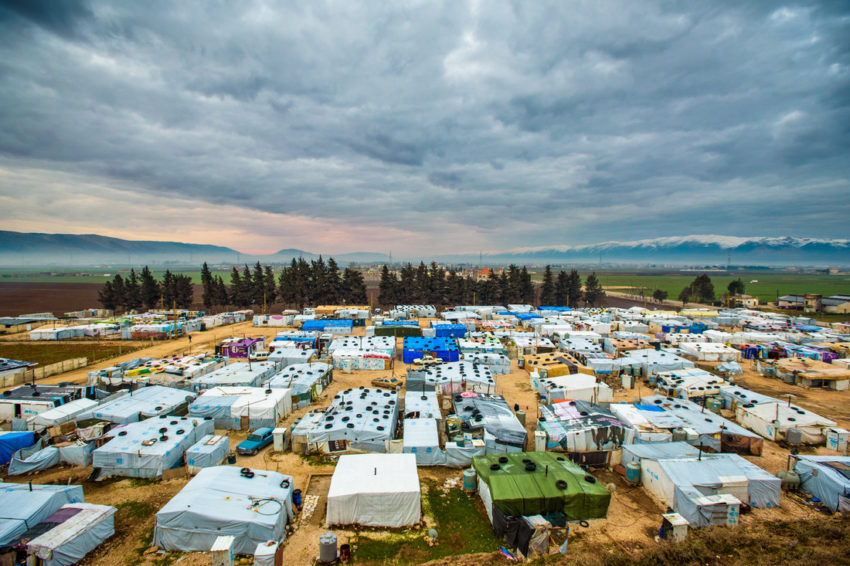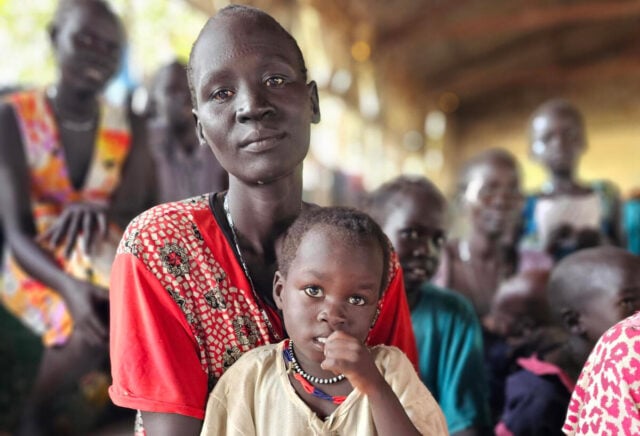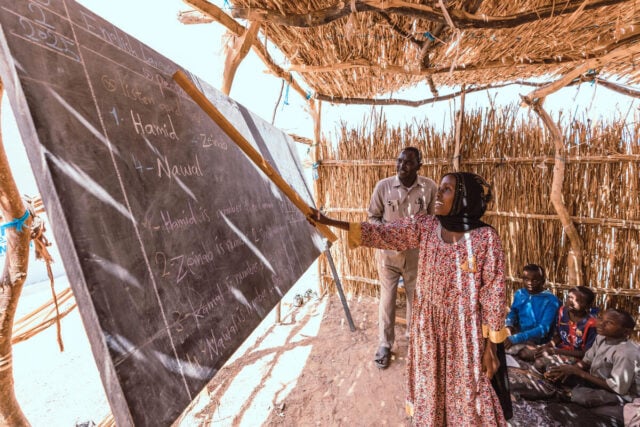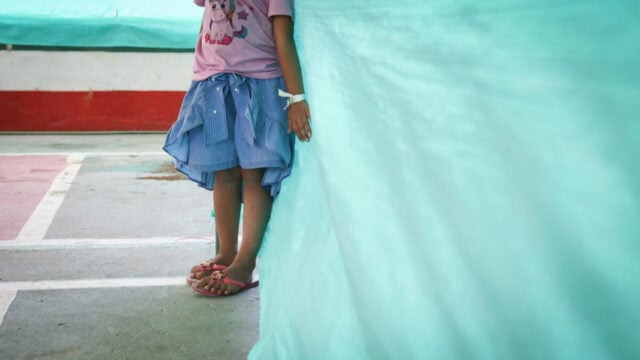Their struggles are daily, if not hourly. Amid shattered dreams and broken hearts in Lebanon’s Bekaa Valley, Syrian refugee children like Ali, Hassan, Nour, Marie, and Ayat live in shelters that are haphazard jumbles near the Syrian border.
Twelve-year-old Ali spends his days wading against traffic and the tides of despair to eke out a living for his family by selling tissues.
“Our situation is very bad,” Ali says.
The girls, Nour, Marie, and Ayat, once academic overachievers, spend their time in mind-numbing boredom. Their memories of what it was like to learn, read, and discover are fading.
Hassan, 10, big brother to a family of little sisters, worries about keeping them warm from the chill of endless nights.
In “Syria Crisis: Children Fleeing Violence,” a 2:28-minute video produced by World Vision, Syrian refugee children share moments of their life — their stories of survival, loss, pain, and hardship. They also share their hope to return home. But their long wait is now getting much longer.
Ali, the tissue boy
With a plastic bundle thrown over his shoulder, the boy spends his days selling tissues by the roadside.
The last time he went to school was the day his family fled Syria.
That was three years ago.
He had family, friends, and a future. But all that shattered when violence erupted in his hometown uprooting him and his family from Syria.
He remembers the day well.
Ali says his mom came to get him and his brothers and they fled for Lebanon. As they drove through their city, they saw unimaginable horrors.
“When we arrived (in town) we saw them slaughtering people. We saw heads on the ground. I won’t forget it,” he says. In the video, the boy looks away, his brown eyes darting away from the camera. He bites the corner of his lip.
“It’s been three years, and I haven’t forgot it. I saw it with my bare eyes, and I will never forget it,” he says.
He has seen more than any child or adult should see, yet he clings to a simple dream. When I ask what he’d wish for if he could have anything, he says, “I hope to read.”
Ali’s story is not new.
The conflict in Syria and violence spilling over into neighboring countries put at least 2.8 million children out of school — some for three years or more. Experts warn that if the immediate needs for education are not met an entire generation could be lost.
Ali would like to go to school, but he is the sole provider for his family because his father is ill. Many other children carry that responsibility.
Ali earns $4 every day — crucial to his family’s survival. And the tissues he sells are more than a luxury for the people who purchase them. They’re a necessity here for Syrian families in the Bekaa, a place of tears.
Nour’s lost way of life
The place is bleak and made of cement, the walls and floors hard and rigid.
Nour, 14, lives in this place, an unfinished apartment building with 20 other Syrian refugees from five different families.
We used to live in paradise.—Nour
She lives with her mother and sister. Her father went out to buy bread for the family in Syria one day and never came back. He was killed in a rocket attack.
Children here have lost loved ones, friends, and teachers to the war.
For Nour, she lost her way of life too.
“We used to live in a paradise,” says Nour. She says that when she was in Syria she’d heard of people who went to university. She dreamed of going too. The war changed all that. Now, she’s given up hope of ever returning to school.
With the conflict in its fifth year, more than 3.2 million people have sought refuge in neighboring countries, including Lebanon, Jordan, Turkey, and Iraq. Nearly half are children.
Nour’s 18-year-old sister is the only one in the house who has a job. She works at a plastics factory. Her shift: 6 days a week, 8 hours a day for $166 month. That’s about $3.50 a day.
It’s not a lot here, barely enough to buy a few things for her family, who lives in a place far from their familiar paradise, missing out on a normal life, school, and education, and most importantly, a father’s love.
Maria: ‘I was number one’
Maria misses school more than anything.
“I used to love school,” she says. “I was number one in my class. Mathematics was my favorite subject.”
Even before leaving Syria, Marie had to stop going to school. Her mom, Miriam, says the kids couldn’t go to school for fear of bombings and kidnappings.
Kidnapping, bombing, and shooting in their neighborhood sent Maria and her family fleeing to Lebanon.
The decline in education for Syrian children has been the sharpest and most rapid in the history of the region, according to the United Nations.
For children inside Syria, the reasons for halting education are many: schools destroyed or occupied by warring groups or displaced families, teachers absent or deceased, and insecurity.
For refugee families who don’t live in camps, paying rent and other expenses can make it impossible for parents to afford transportation, books, and tuition for their children.
When Maria’s family first arrived in Lebanon, the family moved into a rented house. Their savings ran out, and they moved to a tent on vacant land in what aid organizations call informal tent settlements. They now pay $300 every nine months for rent and about $50 a month for electricity.
Aid to help families is falling short.
An e-Card issued by the World Food Programme provides $19 per person, per month. It had been $30 but was recently decreased to $19 because of a lack of international funding.
Ayat’s space
Ayat, 12, arrived in the Bekaa Valley from Syria about a year ago.
“We were living a happy life, but things got bad,” she says. She lives in a tent that just barely withstands the winds and winter weather.
“Sometimes it gets so windy, that the tent barely stands,” she says.
Her respite is spending time in the World Vision-funded Child-Friendly Space.
Souad, a teacher for 12 years and now a World Vision staff member, runs the Child-Friendly Space where Ayat spends her days.
This Child-Friendly Space holds four 75-minute sessions a day, four days a week for about 160 children, most from nearby settlements. Souad says that without World Vision’s Child-Friendly Space, children ages 5 to 11 wouldn’t have any schooling at all.
Child-Friendly Spaces are one of World Vision’s emergency interventions, providing an environment for informal learning, games, singing, and just plain fun. But they serve another purpose as well.
World Vision runs education programs in here to help displaced children learn to read, write, and do math. It also helps children socialize and express themselves during the recovery process.
They provide psychosocial programs, an outlet to help children to process the images of war, violence, and loss. “They tell us about deaths, their houses being destroyed,” Souad says.
Here, Souad makes sure children listen to calm music and imagine themselves in a garden. They try to forget, and they learn to dream again. This day they sang a Syrian song about freedom.
It says: “Sing with us, and we’ll make a glorious world.”
Hassan keeps warm
When the cold winter winds blow through their unheated basement room, 10-year-old Hassan becomes the big brother, making his younger sisters huddle in front of the small space heater before he gets warm.
When the heater works, that is.
“It gets so windy the stove doesn’t work,” he says, “and there’s not electricity all the time so the heater doesn’t always work. When it’s really cold I can’t breathe normally.”
Little has been normal in Hassan’s life since he and his family came to Lebanon from Syria six months ago.
Like millions of other Syrians, the family left to escape the fighting. Bombings near Hassan’s school terrified him.
He remembers one day when the militants actually came in the school. “I felt horrified,” he says, adding, “because it was the first time I saw a rifle, and I was afraid they might shoot us.”
There are an estimated 400,000 Syrian refugees in the Bekaa Valley who, like Hassan and his family, are trying to eke out a meager existence while clinging to their dream of returning to their homeland.
“When I would get really cold,” Hassan remembers, “I used to think about getting back to Syria. It helps me get warm.”




